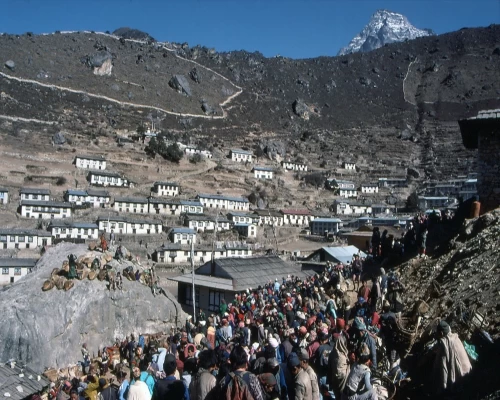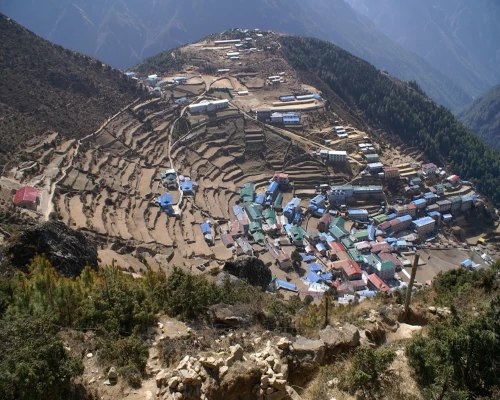Everest View Trek, a moderate trek set within the timeframe of the busy, offers glorious views of Everest while not a lot of gain in altitude(max: 3867m). Expansive spectacular scenery, majestic mountains, and distinctive Asian culture make the teahouse/camping route outstanding. Everest view trekking is a popular worldwide trek in Nepal. The tour is non-technical, and acclimation is punctually taken into thought. After a short yet exotic flight from Kathmandu to Lukla, showing the scenic beauty of greenery and breathtaking white mountains, our trek begins.
We leave the beautiful village ofLukla and take a short walk to Phakding, where acclimatization activities await. The next day we move through pine forests and rhododendrons in the Sagarmatha National Park. The route continues through woods and bridges to the confluence of Dudh Koshi and Bhote Koshi rivers, which ascends further up to Namche Bazaar (3440m) in the Everest Region. At Namche, we rest one more day for acclimatization while enjoying this high-altitude heaven and learning about Sherpa culture, high-altitude lifestyle, rare flora and fauna, and Everest climbers. Namche bazaar is a getaway to go Everest base camp trek too.
Tyangboche, our next village, is home to the highest Buddhist monastery in the world (4100m) and is also renowned as one of the best places for photographers to capture Mount Everest and other nearby peaks. The trek from Tyangboche to Namche is mostly downhill, with a few steep ascents. Next, we pass the traditional villages of Khumjungand Khunde and a monastery with Yeti Scalp.
Find a trip according to your time and budget in the Everest area.
The Everest view Trek is famous not only because of its proximity to the world's highest peak but also because of its hospitable Sherpa people, diverse cultures and traditions, attractive towns, colorful festivals, and monasteries. This excursion will provide you with a complete insight into Sherpa culture while avoiding the difficulties of high-altitude mountaineering. The Everest Panorama trip begins with a short flight from Kathmandu to Lukla Airport, after which the trail follows the classic route across the Dudh Koshi River until you reach Namche Bazaar, where you will stay for a day and explore the Sherpa hamlet.
The next day, you will walk to Everest View Point and Everest View Hotel to see the panoramic mountain views.
Following the hike paths will bring you to various Sherpa settlements such as Khunde, Phortse, Khumjung, and many more little villages, all of which provide breathtaking vistas of snow-capped mountains rising above the sky.
Not only can you view these fantastic mountains from each hamlet, but you can also learn about Sherpa culture, visit monasteries, and learn about the Himalayan people's way of life. The trekking will guide us later to the very renowned Tengboche Monastery.
One of the top locations offering panoramic views of various mountain panoramas is considered one of the best. At Everest View Point, you may walk about and take in the breathtaking views of a variety of spectacular mountains, including Mt. Everest, tour Khumjung hamlet, and Khumjung monastery, and snap photos with the Himalayas and magnificent landscapes as a backdrop.
If you like, you may also go on an expedition up to Ama Dablam base camp, following which you will retrace your steps down to Lukla and fly back to Kathmandu. Tyangboche is home to the world's tallest Buddhist monastery (4100m). It is known for being one of the most significant spots for photographers to catch Mount Everest and other adjacent peaks. The walk from Tyangboche to Namche is primarily downhill, with a few steep ascents for good measure. We drive by Khumjung and Khunde, two traditional settlements, and a monastery with Yeti Scalp. The adventure continues in the presence of abundant wilderness and breathtaking mountain views.
The majority of Everest treks are long and complex. This one, though, is different. This walk includes all of the attractions of the Everest area, hiking, and trekking in Nepal. The excursion integrates Everest's rich cultural past with its breathtaking natural splendor. As a result, the tour is simple and appropriate for individuals of all ages. The hike is both visually appealing and entertaining.
Overall, the Everest View Trek allows you to experience authentic alpine living in a short amount of time. It helps you to immerse yourself more deeply in their culture while also giving you more time to admire its natural, unadulterated beauty. Furthermore, whether you select a simple trip or a challenging trek, each visit to Everest is rewarding. It will be well worth your time and effort to come here.
Best Time for Everest View Trek 2026-2027
It is always suggested that spring and autumn are the best times for excursions. It's the season of sunshine, flowers, and unobstructed views. In April, though, there may be some rain or clouds. Trekking in May, just after the Winter, is delightful. The temperature is around 15 ° Celsius, and the Rhododendrons add to the overall beauty of the scene. When it comes to Everest hiking, there is no such thing as a "best season." Every season is distinct and beautiful in its way. Due to the consistent climate, trekking during the summer, i.e., fall. Rhododendron blossoms abound in the springtime. Finally, the off-season, such as monsoon and Winter, is less busy. As a result, you may relax and enjoy the natural beauty and warmth on your own.
Trekkers escape the monsoon season, which runs from July to August, and the winter season, which runs from January to February. On the other hand, April–May, and October–November are the busiest months.
This Everest Trek is very enjoyable in the Winter. If you're traveling without a guide, try to avoid the busiest times. There's a potential you'll meet up with other hikers along the road who can assist you.
Trekkers escape the monsoon season, which runs from July to August, and the winter season, which runs from January to February. On the other hand, April–May, and October–November are the busiest months. In Nepal, the monsoon starts in June and ends in August. Also called the wet season of the year. It is the minor traveling season as the rain cause mud, landslide risks, blurred views, diseases, and leeches that disappoint trekkers from traveling. Constant rain and cloudy sky make the trip boring and irritating, and taking a flight to/ from Lukla can be risky too.
Everest Base Camp Trek doesn't attract many tourists this season. The monsoon season in Nepal runs from June to August. She was also known as the year's rainy season. It is the less traveled season because mud, avalanche dangers, clouded vistas, illnesses, and leeches deter trekkers. The constant rain and gloomy skies make the journey tedious and frustrating, and flying to/from Lukla might also be perilous. So this time of year, the Everest view Trek gets fewer travelers.
If you are doing the Everest region tour, it is crucial to know the best time. So, as you seem pretty interested, here we have noted when you can do the trek.
- Everest View Trek in Autumn
The best time of the year is autumn for the Everest view trek. Perfect weather with clear blue sky and 100 % visibility. September, October, and November are known as Nepal autumn times.
- Everest View Trek in Spring
Spring is the best time for trekking on Everest. This is a time of greenery in nature and blooming flowers all around your spring season, known as the march, April, and May in Nepal. Typically morning weather is best in spring compared to the evening, so we start our day trek early and stop early for overnight. However, we can get thunder and light rain in the evening.
- Everest View Trek in Winter
Nepal experiences cold weather during Winter. But you can’t put Winter out for trekking. The three months of Winter are December, January, and February. You can visit the Everest view during the season. We’ll tell you why. We can get snow from the very first day of the trek.
The weather will be best in Winter in terms of visibility, but it will be a frozen trek. I highly recommend the Everest view trek in Winter because of less crowded and feels like Yeti in the middle of snow all around.
- Everest View Trek in Summer
Still, you can do the trek in summer, but we do not recommend it in Summer. Visibility is low, and there is a chance of getting rain, but if you are lucky, it will be cleared up after the rain. June, July August is the primary Month of summer in Nepal. Late in summer, August weather is better than in June and July.
Last Minute Booking & Early Booking offers or Inquiries for Everest View Trek
You can call us ( +9779849023179 - Dipak Pande) and WhatsApp, Viber, WeChat, and line available 24 hrs or email [email protected]
Every Month we have fixed departures For Everest view trekking 2025-2026
| Months of departure | Cost/ Price | Book Now |
|---|---|---|
| January | 950 | Check Availability |
| February | 950 | Check Availability |
| march | 950 | Check Availability |
| April | 950 | Check Availability |
| May | 950 | Check Availability |
| June | 950 | Check Availability |
| July | 950 | Check Availability |
| August | 950 | Check Availability |
| September | 950 | Check Availability |
| October | 950 | Check Availability |
| November | 950 | Check Availability |
| December | 950 | Check Availability |
IF YOU ARE LOOKING FOR LUXURY ACCOMMODATION ON THE SAME TREK FOLLOW THESE OPTIONS.
Everest View Trek Outline itinerary
Day 1:Arrival in Kathmandu.(1320m)
Day 2:Kathmandu - Lukla - Phakding (2,610m): 3-4 hour
Day 3:Trek from Phakding to Namche Bazaar (3,443 m): 5-6 Hours
Day 4:Namche Bazaar: Rest day
Day 5:Trek to Tengboche (3875m.) 5- 6 Hours
Day 6:Trek Tengboche to Namche Bazaar (3443m.) 4-5 Hours
Day 7:Trek from Namche Bazaar to Lukla (2850 m.)
Day 8:Fly from Lukla to Kathmandu(1320m)
Day 9:Airport Drop









